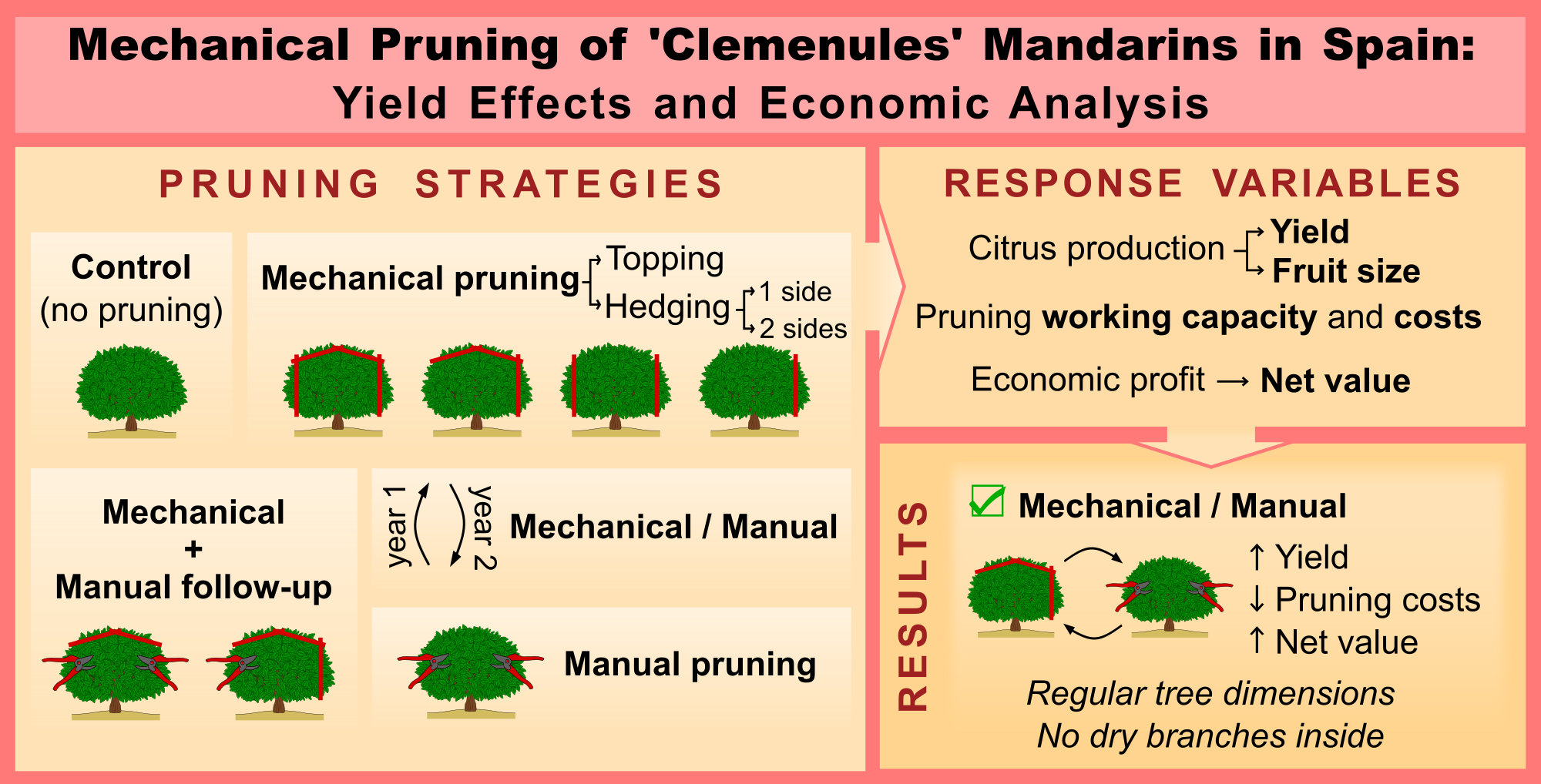Pruning is one of the most expensive tasks in citrus production, and its mechanization could increase the productivity and competitiveness of citrus farms. The effect of mechanical pruning on yield depends on the variety, crop condition, and location; among other factors. The ‘Clemenules’ mandarin variety is one of the most important ones.
- citrus
- mechanization
- manual pruning
- yield
1. Introduction
2. Effects of Pruning Strategy on Yield and Fruit Size
The pruning strategy can affect the yield. In fact, in the first year of assay, the strategies involving topping led to significantly reduced yields in comparison with the rest of the strategies, in a similar way to that observed by Wheaton et al. [28][32] and Kallsen [29][33]. However, in t whis work, it was also observed that after the yield reduction for the first year in the strategies involving topping, in the second and third years, the yield was recovered and this behaviour was also found in ‘Ponkan’ tangerines, according to Mendonça et al. [30][34]. Anyway, the effects of pruning strategies seem to be noticed after some years of experience. In the fourth year, trees with mechanical pruning for four consecutive years had lower yield although the differences were not significant. Meanwhile, strategies that annually alternated mechanical pruning with manual pruning had a higher yield, similar to those the manual and control strategies. As observed by Martin-Gorriz et al. [22] in ‘Fortune’ mandarins, the annual or biannual alternation of manual pruning with mechanical pruning obtained an accumulated yield close to that of continued manual pruning and a higher yield than that obtained with mechanical pruning only. In ‘Salustiana’ oranges, there was a reduction of 17% in the yield of the trees that were pruned mechanically compared to the hand-pruned trees considering the average yield of the four years [31][32][29,42]. Continued mechanical pruning produces zig-zag branches that become unproductive over time, and more severe rejuvenation pruning is needed after a few years [16]. Alternating mechanical pruning with selective manual pruning avoids the accumulation of unproductive branches in the canopy, and avoids having to undertake a more severe rejuvenation pruning, with the consequent yield reduction in production that it would entail for that year.
In contrast to these results, in ‘Navel Foyos’ oranges, no significant differences in yield and fruit size between manual and mechanical pruning strategies were found for the three years [11] and this was also the case with those obtained for ‘Washington Navel’ oranges, where the average yields for the four years in the manual pruning strategy, in the mechanical pruning strategy, and in the strategy involving a mix of mechanical and manual pruning were similar [31][32][29,42]. Moreover, in ‘Nadorcott’, a mandarin variety with a marked biennial bearing, which means that trees will have great fruiting one year and very little flowering the following year, Mesejo et al. [16] demonstrated that cutting the flowering shoots annually with a pruning strategy based on topping and hedging on both sides and with different severity levels of the topping (greater or lesser depth), between 7.2% and 24.5% greater yields, respectively, were obtained, compared to non-pruned trees, after four years of experimentation.
Agustí et al. [33][43] indicated that the size of the fruit was inversely related to the number of fruits per tree, although this relationship was only clear under conditions of low productivity. If the yield was high, the correlation between both variables would be low. In t whis work, it was observed that the sizes of the fruits decreased as the yield increased, although that relationship was low, in a similar way to that which was observed by Martin-Gorriz et al. [22]. However, when considering the pruning strategies, this trend could not be observed. In some cases, strategies with lower production also had smaller fruits and vice versa. Ahmad et al. [34][44] found no significant differences in fruit size between pruned and non-pruned trees in the ‘Kinnow’ mandarin hybrid. Bevington and Bacon [13] did not find a consistent relationship between hedging and fruit size, although on average, the unpruned trees had smaller fruits. However, Morales et al. [19] observed that pruning (topping, with or without skirting) increased the percentage of large fruits and reduced the number of small fruits, as well as decreasing yields, of ‘Orlando’ tangelo.
3. Conclusions
After four years of pruning experimentation in ‘Clemenules’, it may be concluded that alternating mechanical pruning in one year with manual pruning in the next year may be a better option than using exclusively mechanical pruning or mechanical pruning with manual follow-up every year because the yield obtained with the former approach was higher and similar to those of the manual and control (no pruning) strategies. Furthermore, with this system, the dry branches would be removed from the interior of the tree, internal aeration would be improved, and the problems of non-selective mechanical pruning continued over time would be avoided. At the same time, the dimensions of the trees would be more regular, facilitating the movement of tractors between the tree rows. In addition, this strategy would mean a significant cost reduction compared to traditional manual pruning. For all these reasons, this system should be boosted in farm practices through the diffusion of these results in agricultural extension channels. Among the strategies that alternated mechanical and manual pruning yearly, the strategy that combined mechanical pruning in topping and one-sided hedging on with completely manual pruning in the following year was the one with the highest yield (91 kg∙tree−1 on average for the four years). This strategy, by including the topping cut, makes it possible to control the growth of the trees, since, if the growth in height of citrus trees is not limited, the harvesting tasks, which in Spain are usually carried out manually, and the spraying of plant protection products will become difficult.
